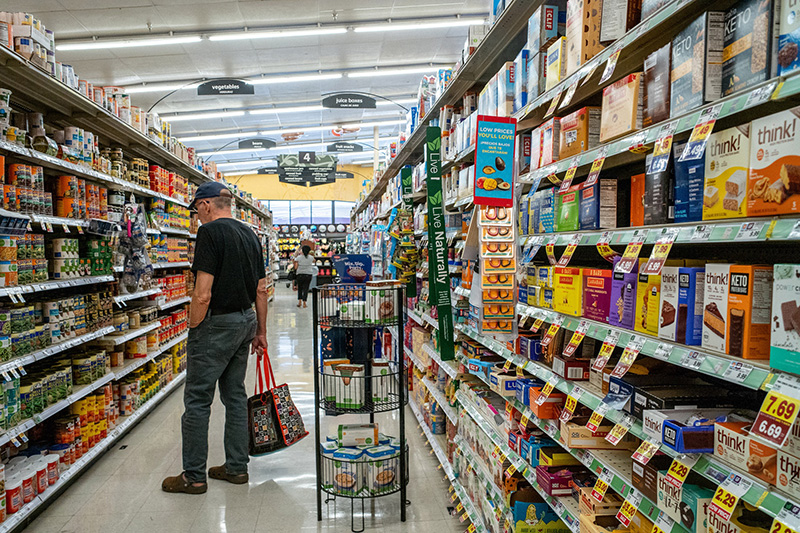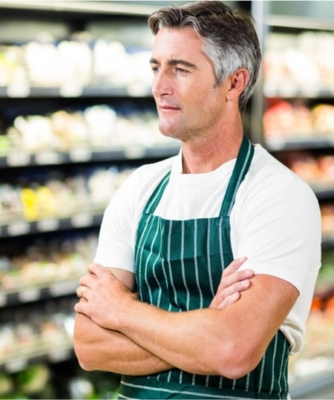The Kroger-Albertsons Merger is Looming:
How Can Regional Grocers Win in a Rapidly Consolidating Market?
Back to All
Insights
October 14, 2022. That was the day Kroger-Albertsons took the grocery world by storm and announced their intentions to combine forces. Fast forward to today—nearly two years in trail of the initial rumblings—and the case is, slowly but surely, feeling more and more like a “go.”
While the case continues to make headlines, it certainly hasn’t been easy for these two industry titans. As recently as this week, a Colorado judge temporarily delayed the merger until at least September 30th, when a trial will be held to assess the deal. Skepticism by the Federal Trade Commission (FTC), who claims that the new organization would violate anti-trust statutes, has ushered in several waves of concessions.
In April, Kroger upped the number of divested stores by a staggering 40%, creating a total of 580 that it plans to sell off to C&S Wholesale Grocers as part of its pitch for competition. It will also provide C&S the rights to operate major brands like Safeway in large markets like Arizona and Colorado, in addition to the 8 distribution centers and 5 private label brands it previously offered up in 2023.
On top of all of this, executives doubled-down on their initial commitments to pass through $500M in price reductions to customers, invest $1.3Bn in store remodels, and increase employee salaries/benefits by a staggering $1Bn.
Even with all the noise generated by the latest rounds of FTC pushback—after all, this is the first major consolidation to be challenged since 2007—these commitments further suggest the deal will go through. Thus, it should come as no surprise that executives from both companies are committed to seeing this deal through, and several have even alluded to their desire to pursue litigation should things take a turn. Given the mutual appetite among Kroger-Albertsons stakeholders to expedite the acquisition, regional grocers need to act now to understand the implications and think through how to navigate a drastically different world for grocery.
The Combined Strengths of Kroger & Albertsons
As we reported in our previous piece, the combined entity would serve 85 million American households across 5,000 stores, generating approximately $200 billion in revenue and making it the second largest food retailer in the US, only behind Walmart. And while the deal always made sense from a synergy perspective—Kroger serving the Midwest while Albertsons focuses on the coasts—the deal carries even more strategic importance as both companies report slowing growth. Once the merger passes, the deal logic will come to life, and the combined capabilities will far exceed any regional player. Key strengths will include:
1) Exceptional Portfolio of Private Brands

The new company would operate a footprint of more than 50 manufacturing facilities and would generate a combined $45 billion dollars for their private label business. Kroger’s extensive private label offerings span four segments with clear strategic positioning that provide options for every class of shopper, while their value brand, Smart Way, was ranked the fastest-growing private label brand in 2023.
As for Albertsons, the company carries more than 8,000 SKU’s. They recently completed an initiative to consolidate all Albertsons private brands under their Signature Selection umbrella and doubled down on their commitment to quality products with a campaign permitting refunds if customers aren’t 100% satisfied. Most importantly, the strategic emphasis on their private brands will be a key vehicle to allay FTC concerns around any potential price gouging, since private brands fundamentally exhibit lower price points.
2) A Robust Data & Analytics Arm

Officially known as 84.51, Kroger’s data science organization provides Merchandising teams and CPG companies insights into the buying habits of 60 million households and 2 billion transactions a year. Similarly, Albertsons has 38 million loyalty members from which it can also generate strategic insights. Thus, the combined forces of Kroger’s “Plus Card” and Albertsons’ “For U” program will account for a repository containing first-party data for millions of households across 48 states of the country. In combining analytics capabilities with customer reach, the newco will be able to leverage even more data and offer even more personalized recommendations, discounts and rewards to its customers.
3) Deep Penetration into Alternative Profit Channels like Retail Media Networks

Perhaps a less obvious implication of the merger, retail media networks have been identified as a key strategic pillar to generate alternative profits. Retail media networks are expected to generate $106 billion in U.S. ad spending by 2027 – more than double the $45 billion that was expected in 2023. As such, both Kroger and Albertsons have invested heavily in their offerings. Kroger Precision Marketing is expected to grow 20% in 2024 alone, while Albertsons recently announced a groundbreaking partnership with commerce media solution Criteo to expand its capabilities. The combined forces of these market leaders will drive share not only in their core businesses but dominate revenue in their ancillary channels as well.
4) Broad, national store network will provide long-term benefits for more than 85 million households, narrowing Kroger’s gap to Walmart and Amazon

The new network will feature ~5,000 stores serving an estimated 85 million households —by far the most of any grocery chain. Most importantly, it will take Kroger closer to the customer reach of both Walmart and Amazon. The proposed fleet map is geographically balanced, and a robust distribution network will minimize delivery costs, allowing customers access to a broader range of products at unparalleled speeds. Lower prices—particularly on the Albertson’s side—will trickle down to consumers, who will also benefit from better and more targeted marketing campaigns.
Clearly, the combined entity will be a powerhouse. For regional grocers, the emergence of this juggernaut means only one thing—now is the time to make it or break it. The new company will use its scale to expand in regional markets, taking with it the customers who once shopped at the local chains.
While it’s not necessary to hit the panic button—yet—it is time for regional grocers to take a step back and understand what they can do to successfully compete in this dawn of a new era.
What Regional Grocers Should Do
Despite these significant changes to the market, regional grocers will continue to have a reason to exist by focusing on customer needs with localized offerings, exceptional convenience, and easy-to-access fresh foods. However, they will need to up their game to stay competitive, and even consider acquisition strategy if the right situation permits.
Agnostic of approach, protecting the bottom line needs to be the #1 priority for smaller, regional players. This doesn’t necessarily need to play out through cost-driven solutions, though retailers tend to seek those out in times of significant disruption. In fact, growth-centric options are a viable strategy to set your stores apart and take performance to the next level.
If regional grocers are to continue their success story, leadership must seriously consider the below actions, prioritized by potential for impact, to preserve their margins:
1) Heavily invest in regional brands and local assortment
Regional grocers are generally in better touch with their customers. Being closer to consumers and the brands they love can provide a distinct advantage over national brands, since regional players typically offer high-quality local items that drive loyalty. Customers who know those brands, or even the people who run those run brands, will seek them out in local stores, shop there more often, and, in many cases, drive incremental traffic from family and friends.
One retailer particularly known for this strategy is Sprouts, which had almost 20% of produce sales generated from local farmers merchandise in 2023. Their investment in local and regional products has clearly paid off, enabling them to grow their sales by 3% despite a tough economic environment while rapidly expanding into new markets beyond their western U.S. roots.
2) Leverage your unique positioning to compete on price and appeal to customers
National vendors may not want to cede lower prices to their largest customers. Why? It’s a question of volume, where even the smallest discounts can have cascading impacts on margin. Thus, regional players should lean into their unique position by negotiating for lower prices with key vendors, which they can then pass onto consumers.
Another well-worn strategy to compete on price is private label. Sprouts’ store brands accounted for more than 20% of its revenue in 2023, nearly double the sales share in 2017. Additionally, Kowalski’s Markets in Minnesota has rolled out private label lines amounting to 800 SKU’s and has paired the rollout with in-person tasting events to market the products to their customers.
3) Use third-party data analytics to keep up with “The Big Guys”
Setting up an internal data analytics arm to compete with Kroger may be a bridge too far, but that’s not to say providers like Nielsen, Numerator or Spins can’t do it for you. From pricing analytics to consumer behavior and shopping patterns, these specialists have the toolkits to get a workable solution set up quickly. Not to mention, their host of industry data allows you to compare your performance to other grocers and, what’s more, vendors will even offer up services in exchange for your sales data.
Use partners like these to unlock the potential of your data and deepen your understanding of your customers and the market. Schnucks and Harps Foods are two great examples of retailers who have taken significant strides in recent years to strengthen their analytics to better serve their customers.
It is critical for regional players to fully realize the importance of their own data and how it can be monetized or leveraged to improve analytics
4) Invest in customer service and community engagement
Smaller grocers should lean on what they do best — offering superior quality and highly personalized customer service, which can often go unnoticed by “the big guys.” Smaller players can leverage this strength by offering an outstanding in-store experience while investing in their connection with the community outside of the store. Take Wegmans as an example, which has held the first-place spot in the Consumer Reports Research index since 2006 (in fact, all top spots were held by regional/local chains with the exception of Trader Joe’s).
Wegmans has attributed its success to the quality and courtesy of its staff, which it empowers by hosting client-facing training, paying for knowledge-enriching trips, and placing expert employees in their respective departments to better serve customers. Indeed, Wegmans leverages their customer service to further amplify the success they generate from more traditional regional levers like merchandising authority and assortment.
5) Consider M&A to improve economies of scale
Make no mistake—there has been no shortage of acquisition activity in recent months as the merger looms high above the grocery industry. In April, Midwest chain Hy-Vee entered the Indiana market after striking a deal to acquire Strack & Van Til’s 22 stores in the northwest part of the state. Similarly, SpartanNash grew its footprint in Wisconsin with the purchase of Metcalfe’s Markets. While mergers may not be the first lever to consider for all regional players—M&A without a solid underlying strategy is a recipe for disaster—they can be a fast, impactful way to transform a business.
For one, larger firms benefit from economies of scale during purchasing and also tend to receive better service levels as key accounts. Synergies can be realized through headcount and distribution network optimization. Moreover, companies can maximize potential by optimizing capabilities, much as Kroger and Albertsons will do once cleared to move forward.
6) Keep an eye out for talent either laid off or distributed by the merger
While the new company has agreed to keep all storefronts open (inclusive of divested locations), that sentiment cannot be applied to corporate functions. It is hard to imagine a scenario where all commercial roles are retained, especially in the pursuit of synergies post-acquisition. Therefore, a lot of talented people will be freed up in the market, and regional grocers should act quickly to find these individuals and determine how to best work them into their business.
But before being able to do that, local grocers must evaluate what exactly it is they are looking for and conduct assessments of current employees to determine which business units and positions can use the talent. Keep in mind that newcomers may seem frustrated after experiencing layoffs, so it’s important to be welcoming of new faces while staying focused on critical business outcomes. This approach will help align incentives and build a culture rooted in the celebration of shared success.
7) Tap into your lean operating model to make quick, decisive judgements on the business
It’s no secret that the bigger a business gets, the slower it tends to move. Regional grocers can take full advantage of this vulnerability by sidestepping the red tape that slows down bigger players when they strive to execute on strategic initiatives. By investing on tailorized technology needs, leveraging AI, adjusting core processes, and eliminating time-consuming tasks on teams, regional grocers will be able to react – even faster than they already do – when carrying out essential tasks (introducing new products, adjusting store formats, optimizing space allocation, etc.)
Make no mistake—all of these activities are the heart and soul of grocery retailing operations—but with current and fast-changing customer needs, being nimble and rapid on those daily routines carries that much more importance. Those who can operate at the fastest of speeds will certainly be capable to protect and expand their position in the space.
Conclusion & How We Can Help
A grocery-style spinoff of the “David & Goliath” story is in the works—and it will move faster than common literature suggests. Thus, it is critical for regional grocers to start developing their own strategies as this story comes to life. At A&M Consumer & Retail Group, we are committed to helping our clients come out on the right side of disruption. Do not hesitate to reach out if we can be of help as you navigate the next steps in this ever-challenging retail environment.
By Dave Ritter, Jeremy Levine, Conor Gaffney and Bruno Breckenfeld
